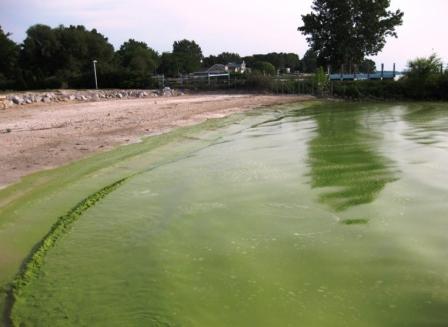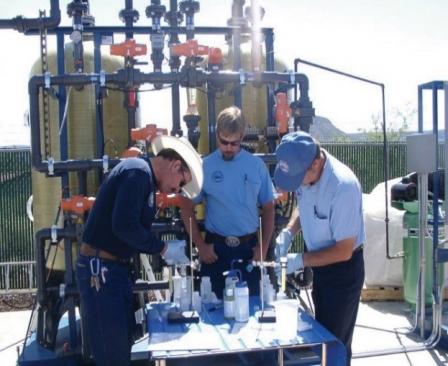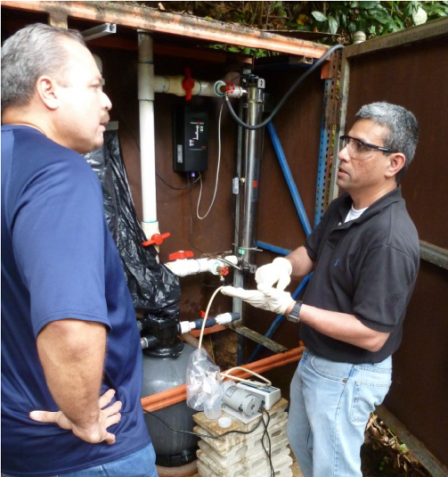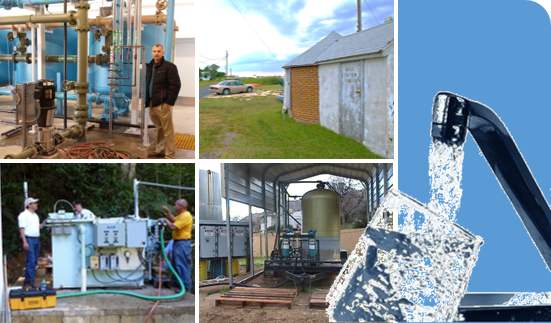Small Drinking Water Systems Research
Information on this Page
There are over 145,000 active public water systems in the United States (including territories). Of these, 97% are considered small systems under the Safe Drinking Water Act, meaning they serve 10,000 or fewer people.
While many of these active small systems consistently provide safe, reliable drinking water to their customers, many face a number of challenges in their ability to achieve and maintain system sustainability. Some of these small system challenges include lack of expertise to choose, operate, and maintain systems; lack of financial resources; aging infrastructure; limited options for residual disposal; and state agencies with limited resources to support the large number of small systems.
EPA's small systems research is developing tools, technologies, and approaches to help small systems lower costs and provide safe drinking water now and in the future.
Fact Sheet: Small Drinking Water Systems Research and Development
Treatment for Contaminants of Emerging Concern (CECs)
 Photo credit: NOAA, July 2009
Photo credit: NOAA, July 2009
Drinking water treatment plants (DWTPs) are increasingly being challenged by changes in the quality of their source waters and by their aging treatment and distribution system infrastructure. Factors such as shrinking water and financial resources, climate change, agricultural runoff, harmful algal blooms (HABs), and industrial land use increase the probability that CECs (chemicals that have not previously been detected in water, or that are being detected at significantly different levels than expected), such as pesticides, pharmaceuticals, personal care products, endocrine disrupting compounds, and algal toxins will remain after treatment, ending up in consumers’ drinking water. This is likely to disproportionately affect small drinking water systems due to limited resources and treatment options, among other factors. Identifying and quantifying the source water and treatment challenges for water systems is an important step towards mitigating present and future risks.
The following studies will help improve our understanding of the spread of contaminants through drinking water treatment, and identify best approaches for removal.
Removal of cyanobacteria and cyanotoxins through drinking water treatment
EPA is examining the spread and removal of cyanobacterial cells and their associated toxins at DWTPs using samples collected throughout treatment trains at facilities along the shoreline of Lake Erie. This study will improve our understanding of the dynamics of algal toxin release or removal through drinking water treatment processes. Additional details can be found here: Harmful Algal Blooms Cyanobacteria.
- Fact Sheet: Evaluation of Current Water Treatment and Distribution System Optimization to Provide Safe Drinking Water from Various Source Water Types and Conditions
- Webinar recording: Current Water Treatment and Distribution System Optimization for Cyanotoxins
Characterizing the fate of contaminants released from landfills in Alaska
In collaboration with five tribal communities, EPA has completed a study characterizing the fate of contaminants released from landfills in rural Alaska and their potential impact on local drinking water sources. Tribal communities of Allakaket, Eek, Ekwok, White Mountain, Fort Yukon, and other dump sites throughout the State of Alaska are using the study findings to improve the management of their landfills.
Removal of Inorganic and Organic Contaminants
 EPA is working to provide information and treatment approaches to small systems to help them manage inorganic contaminants in their water supplies. In addition, the information will assist with revisions to drinking water regulations and can be used by the states for communicating novel and relevant treatment technologies to their systems.
EPA is working to provide information and treatment approaches to small systems to help them manage inorganic contaminants in their water supplies. In addition, the information will assist with revisions to drinking water regulations and can be used by the states for communicating novel and relevant treatment technologies to their systems.
Ammonia Removal Research
Many regions in the U.S. have excessive levels of ammonia in their drinking water source as a result of naturally occurring processes or contamination from agricultural runoff. Ammonia in water does not pose a direct health concern; however, it may pose a concern when nitrification occurs in the drinking water distribution system. Nitrification, is the conversion of the ammonia to nitrite and nitrate by bacteria, and can lead to water quality issues, such as potential pipe corrosion problems, loss of disinfectant, taste and odor complaints, elevated nitrate and nitrite levels, and potential poor water treatment performance. EPA’s research in this area is providing communities with the technologies they need to address these issues.
Highlight: A small community in Iowa relied on individual and neighborhood shallow wells, which became contaminated after a flood in 2008. EPA and the State of Iowa Department of Natural Resources conducted a pilot study using an EPA developed and patented biological water treatment technology for ammonia oxidation. The pilot system, designed, built, and installed by EPA staff, effectively removed ammonia and iron from the community's source water, while keeping nitrite and nitrate levels below their respective maximum contaminant level in the treated water. As part of a federal Housing and Urban Development (HUD) grant, a full-scale water treatment plant based on the pilot system was completed in January 2014. The community now has a functioning public water system that meets all regulations.
Publications:
- Engineering Design and Operation Report – Biological Treatment Process for the Removal of Ammonia from a Small Drinking Water System in Iowa: Pilot to Full-Scale
- Innovative Biological Water Treatment for the Removal of Elevated Ammonia
Arsenic Treatment Technology Demonstrations
EPA is at the forefront of investigating arsenic removal technologies and their cost, including capital and operating costs. From 2002-2012, EPA funded and studied 50 small, full-scale arsenic removal systems in 26 different states impacting over 60,000 consumers. The technologies studied included three that are most commonly utilized by small systems: adsorptive media, iron removal, and coagulation/filtration. The study resulted in the most comprehensive set of performance and cost data ever collected on drinking water treatment for a specific contaminant. The extensive set of data is currently being summarized for informing other communities.
- Arsenic Treatment Technology Demonstrations website
- Webinar recording: Research and Implementation of Arsenic Removal Technologies at Small Community Water Systems
Publications:
- The Costs of Small Drinking Water Systems Removing Arsenic from Groundwater
- Regeneration of Iron-based Adsorptive Media Used for Removing Arsenic from Groundwater
- Arsenic Species in Drinking Water Wells in the USA with High Arsenic Concentrations
Evaluation of cost-effective aeration technologies to address disinfection byproducts (DBPs) compliance
EPA conducted evaluations of cost-effective aeration technology solutions to address DBP compliance, specifically total trihalomethane (TTHM), at a water treatment plant clearwell (storage tank). DBPs form during the drinking water treatment process.
Fluoride Treatment Technologies Research
EPA evaluated full-scale water treatment plants with existing fluoride removal treatment systems and followed with demonstrations of other novel approaches. Systems' operators collected water samples to document performance and to determine the ultimate fate of the contaminants. The results of the studies were used to fill a need for a comprehensive manual on available fluoride removal technologies. The manual supports the fluoride maximum contaminant level (MCL) and provides an in-depth presentation of the steps required to design and operate a fluoride removal plant using activated alumina, which is a reliable and cost-effective process for treating excess fluoride from drinking water supplies. This effort will build confidence in novel technologies and approaches so that communities and state primacy agencies will accept them knowing that they will be successful in removing the contaminants of interest, and without concern about the systems overall sustainability.
Brominated disinfection byproducts (DBPs) studies
To protect public health, public water system (PWS) operators must meet federal limits for disinfection byproducts (DBPs) formed during the water treatment process. A better understanding of the relationship between bromide in source water and DBP formation will help operators in the Ohio River Watershed improve treatment processes, ensure compliance with federal limits, and provide important information to state, local, and federal regulators responsible for protecting the rivers and streams in the watershed.
EPA is evaluating water samples collected at eight PWS in order to investigate relationships between bromide in source water and the formation of brominated DBPs in finished drinking water. Once the results from the collected samples have been finalized, EPA will analyze the data to determine whether correlations exist between bromide in source water and brominated DBP formation. Based on the analysis, EPA will then determine if models can be used to estimate DBP formation, optimize treatment, and inform source control strategies.
Treatment, control, and assessment strategies for lead and copper release
EPA is evaluating water treatment strategies for the control of lead and copper release from drinking water plumbing materials and components. Specifically, scientists are conducting investigations on the impact of water quality on lead and copper release, pipe scale aging on copper release, and complications of metal contamination arising from accumulated deposits of iron, manganese, and aluminum on lead or copper pipe surfaces. EPA is also evaluating the optimization and interaction of treatment processes and the resulting water quality impacts on the nature of mineral scales and deposits in real water systems.
- Webinar recording: orrosion Control for Drinking Water Systems
- Fact sheet: How to Identify Lead Free Certification Marks for Drinking Water System and Plumbing Products
Pathogens and Disinfection
 Drinking water can be a source of waterborne illnesses due to the contamination of source waters or treated water as it moves through the distribution system to consumer taps. The growth of pathogens associated with microbial communities, known as biofilms, can occur on drinking water pipe surfaces. Current treatments include the use of disinfectants, such as chlorine and monochloramine; UV treatment; and filtration. To control disinfection byproducts, many utilities have switched from chlorine to monochloramine as both their primary and residual disinfectant. Previous studies have shown the differences between chlorine and monochloramine at killing specific types of pathogens and their ability to penetrate into biofilms; however, there is limited data on their effectiveness at controlling the occurrence and growth of pathogens in distribution systems.
Drinking water can be a source of waterborne illnesses due to the contamination of source waters or treated water as it moves through the distribution system to consumer taps. The growth of pathogens associated with microbial communities, known as biofilms, can occur on drinking water pipe surfaces. Current treatments include the use of disinfectants, such as chlorine and monochloramine; UV treatment; and filtration. To control disinfection byproducts, many utilities have switched from chlorine to monochloramine as both their primary and residual disinfectant. Previous studies have shown the differences between chlorine and monochloramine at killing specific types of pathogens and their ability to penetrate into biofilms; however, there is limited data on their effectiveness at controlling the occurrence and growth of pathogens in distribution systems.
Water quality issues in large buildings and emerging treatment technologies for premise plumbing-related pathogens
The Safe Drinking Water Act (SDWA) sets limits on water quality indicators for water in the distribution system. Once this distributed water enters a building or household, the responsibility for maintaining water quality shifts to the owners. The latest data for waterborne diseases indicates that premise plumbing-related outbreaks are increasing across the Nation. This fact, and the legal ramifications of waterborne outbreaks, are leading hospital and hotel owners to address water quality in their buildings. EPA is investigating water quality issues in large buildings and evaluating emerging treatment technologies to control premise plumbing-related microbial pathogens, with the goal of providing information to building owners on how water quality changes as it moves through complex premise plumbing systems. These investigations include research on both pathogen and corrosion control.
Validation of ultraviolet (UV) disinfection of ground and surface water systems
UV disinfection is an effective process for inactivating many microbial pathogens found in source waters with the potential as stand-alone treatment or in combination with other disinfectants. Small- to medium-sized drinking water systems often have limited resources and expertise to evaluate and install innovative technologies. As a result, they typically do not optimize operations and often apply significantly higher UV doses than necessary. Currently, there is no standard UV testing protocol for viruses under the Ground Water Rule, and there is a lack of recommendations for efficient operation in small systems for virus inactivation applications. EPA is evaluating new approaches for validating UV reactors to meet groundwater and surface water pathogen inactivation goals, including those for virus control for low-pressure and medium-pressure UV systems. The research study is expected to contribute to better public health protection with more accurate UV dose monitoring and reduced capital and operation and maintenance costs. This work will also reduce the burden on states and utilities to prove a novel UV treatment system complies with the EPA’s UV guidance manual.
Publications:
- Reduction of Microbial Contaminants in Drinking Water by UV Light Technology: ETS UV MODEL UVL-200-4
- Reduction of Microbial Contaminants in Drinking Water by UV Light Technology: ETS UV MODEL ECP-113-5
Field studies of low-pressure UV lamps at ground and surface water systems
Some consumers in small rural communities in Puerto Rico face health risks because they rely on unfiltered ground and surface waters for drinking water. This causes periodic outbreaks of waterborne diseases. The remote communities lack economic and technical capabilities in order to comply with drinking water regulations. In addition, traditional water treatment technologies are expensive to operate and maintain.
In collaboration with partners, EPA evaluated UV disinfection systems in two rural communities to determine the effectiveness of low-pressure UV lamps on inactivating pathogens in groundwater and surface water supplies. For both studies, the operation and maintenance costs associated with water delivery, prefiltration, and disinfection systems were compared. The studies benefited from the inclusion of citizen science, which involved training the communities on the capabilities and operation and maintenance of the UV systems. This research study is expected to provide conceptual diagrams of design alternatives for small systems capable of UV inactivation of chlorine resistant pathogens. Research results and lessons learned will be incorporated into a report on the installation, ease of use, and effectiveness of UV disinfection for both surface and groundwater supplies in rural Non-PRASA communities in Puerto Rico and other tropical environments.
Evaluating the effectiveness of disinfectants on microbial communities in water distribution systems
This research will add to our knowledge of how commonly used disinfectants (chlorine and monochloramine) effect microbial communities, known as biofilms, in drinking water distribution system pipes. Using complex molecular tools, a whole metagenome-based approach was used to evaluate the composition and metabolic potential in these communities. Such information is critical to the design of effective management practices and ultimately helps to prevent waterborne disease and safeguard human health.
Publications:
- Metagenomic analyses of drinking water receiving different disinfection treatments
- Establishment and early succession of bacterial communities in monochloramine-treated drinking water biofilms
Filtration alternatives for small communities and households
This study involved case studies on innovative and commercially available drinking water treatment alternatives for small community water systems. Emphasis was placed on media and membrane filtration technologies capable of meeting the requirements of the Long-Term 2 Enhanced Surface Water Treatment Rule (LT2ESWTR) and the Groundwater Rule. Studies included household water treatment systems for removal of chemicals and pathogens from well water.
Models, Tools, and Databases
Drinking Water Treatability Database (TDB)
The Drinking Water Treatability Database (TDB) presents referenced information on the control of contaminants in drinking water. It allows drinking water utilities, first responders to spills or emergencies, treatment process designers, research organizations, academicians, regulators and others to access referenced information gathered from thousands of literature sources and assembled on one site. It includes more than 25 treatment processes used by drinking water utilities. The literature includes bench-, pilot-, and full-scale studies of surface waters, ground waters and laboratory waters. The literature includes peer-reviewed journals and conferences, other conferences and symposia, research reports, theses, and dissertations.
Cost Models for Drinking Water Treatment Plants
The Safe Drinking Water Act Amendments of 1996, as well as a number of other statutes and executive orders, require that EPA estimate regulatory compliance costs as part of its rulemaking process. A new series of cost models have been designed for the purpose of estimating the national costs of drinking water regulations, although they can also be used at the individual site scale. The models were designed to be transparent and versatile.
- Drinking Water Treatment Technology Unit Cost Models
- Using Work Breakdown Structure Models to Develop Unit Treatment Costs
EPANET
EPANET was developed as a tool for understanding the movement and fate of drinking water constituents within distribution systems, and can be used for many different kinds of applications in distribution systems analysis. Today, engineers and consultants use EPANET to design and size new water infrastructure, retrofit existing aging infrastructure, optimize operations of tanks and pumps, reduce energy usage, investigate water quality problems, and prepare for emergencies. EPANET can also be used to model contamination threats and evaluate resilience to security threats or natural disasters. EPANET's user interface provides a visual network editor that simplifies the process of building piping network models and editing their properties and data.
Environmental Technologies Design Option Tool (ETDOT)
The Environmental Technologies Design Option Tool (ETDOT) is a suite of software models that provides engineers with the capability to evaluate and design systems that use granular activated carbon or ion exchange resins for the removal of contaminants, including PFAS, from drinking water and wastewater.
Breakpoint Chlorination Simulator
The Breakpoint Chlorination Simulator for Drinking Water Systems is a web-based application relevant to drinking water practice was developed to assist water utilities in generating chlorine breakpoint curves. The simulator generates two side-by-side breakpoint curves for comparison purposes with user defined conditions.
Chloramine Formation and Decay Simulator
The Chloramine Formation and Decay Simulator for Drinking Water Systems is a web-based application relevant to drinking water practice was developed to simulate inorganic chloramine formation and subsequent stability, including a simple inorganic chloramine demand reaction for organic matter. It provides two side-by-side simulations and associated graphs to allow comparison of input choices on chloramine formation and decay.
Free Chlorine and Cyanuric Acid Simulator
The Chlorine and Cyanuric Acid System Simulator is an application that simulates water chemistry associated with the free chlorine and cyanuric acid system (i.e., chlorinated cyanurates) at user selected conditions. This allows users to estimate the free chlorine concentration when cyanuric acid is present, as in the case when adding chlorine-containing chemicals (commonly referred to as Dichlor or Trichlor) to water.
Outreach and Training
State and local officials across the Nation are faced with challenges of effectively communicating information and overseeing training for small system owners and operators with a wide range of expertise, skills, and preferences for modes of communication. To ensure these systems are in compliance with regulations enforced by EPA under the Safe Drinking Water Act, these officials need to stay up-to-date on treatment alternatives, regulations, health implications, and emerging contaminants. EPA is committed to helping state and local personnel, as well as small system personnel, to deliver high quality drinking water to their customers by providing information, training, and technical assistance. EPA’s small systems outreach efforts foster collaboration and dissemination of information, which, in turn, will help state agencies communicate the latest scientific advancements and current guidance to their small systems. In addition, EPA’s outreach efforts provide invaluable information from the states to EPA researchers on the problems that they are currently encountering in their day-to-day interactions with small systems. EPA scientists can then modify their research to solve real-world problems that small systems are experiencing.
Small Systems Monthly Webinar Series: Challenges and Treatment Solutions for Small Water Systems
EPA's Office of Research and Development and Office of Water host this monthly webinar series to communicate current small drinking water systems research along with Agency priorities. This forum allows EPA to communicate directly with state personnel and others to provide training and foster collaboration and dissemination of information. This, in turn, provides state agencies with the information and resources needed to communicate the latest scientific advancements and current guidance to their small systems. The webinars also provide EPA with invaluable information from the states on challenges they are currently encountering in their interactions with small systems. With this information, EPA scientists and engineers can modify their research to find solutions to real-world problems. Attendees have the option of receiving a certificate for one continuing education contact hour for each webinar. Acceptance of the certificates is contingent on state and/or organization requirements—EPA cannot guarantee acceptance.
Annual EPA Drinking Water Workshop: Small Systems Challenges and Solutions
This annual workshop, typically held in September in the Greater Cincinnati Area (Ohio), is a collaborative effort between EPA and the Association of State Drinking Water Administrators. It is free and open to the public, and offers in-depth training and information for handling small drinking water systems problems and compliance challenges. It is primarily designed for state personnel responsible for drinking water regulations compliance and treatment technologies permitting. The 2020 workshop was help virtually.

